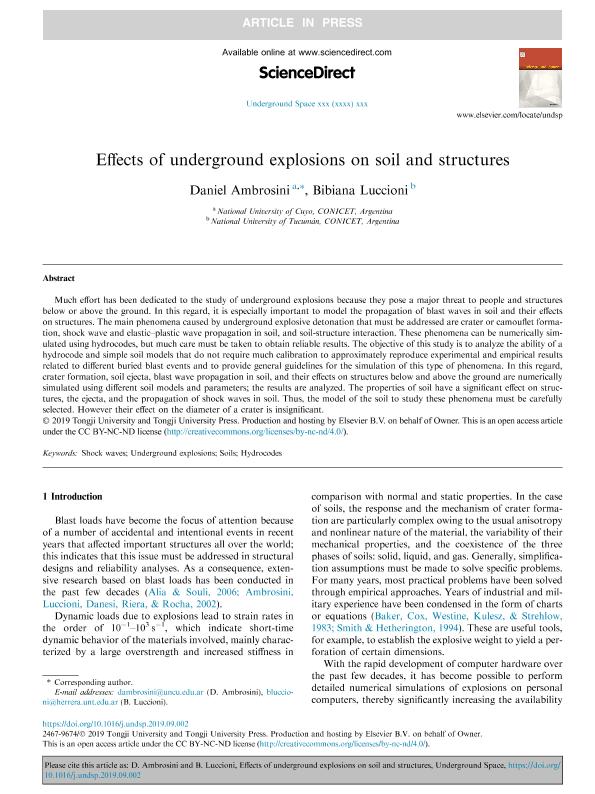Mostrar el registro sencillo del ítem
dc.contributor.author
Ambrosini, Ricardo Daniel

dc.contributor.author
Luccioni, Bibiana Maria

dc.date.available
2020-11-24T15:28:07Z
dc.date.issued
2020-11
dc.identifier.citation
Ambrosini, Ricardo Daniel; Luccioni, Bibiana Maria; Effects of underground explosions on soil and structures; Elsevier; Underground Space; 5; 4; 11-2020; 324-338
dc.identifier.issn
2467-9674
dc.identifier.uri
http://hdl.handle.net/11336/118866
dc.description.abstract
Much effort has been dedicated to the study of underground explosions because they pose a major threat to people and structuresbelow or above the ground. In this regard, it is especially important to model the propagation of blast waves in soil and their effectson structures. The main phenomena caused by underground explosive detonation that must be addressed are crater or camouflet forma-tion, shock wave and elastic?plastic wave propagation in soil, and soil-structure interaction. These phenomena can be numerically sim-ulated using hydrocodes, but much care must be taken to obtain reliable results. The objective of this study is to analyze the ability of ahydrocode and simple soil models that do not require much calibration to approximately reproduce experimental and empirical resultsrelated to different buried blast events and to provide general guidelines for the simulation of this type of phenomena. In this regard,crater formation, soil ejecta, blast wave propagation in soil, and their effects on structures below and above the ground are numericallysimulated using different soil models and parameters; the results are analyzed. The properties of soil have a significant effect on struc-tures, the ejecta, and the propagation of shock waves in soil. Thus, the model of the soil to study these phenomena must be carefullyselected. However their effect on the diameter of a crater is insignificant.
dc.format
application/pdf
dc.language.iso
eng
dc.publisher
Elsevier
dc.rights
info:eu-repo/semantics/openAccess
dc.rights.uri
https://creativecommons.org/licenses/by-nc-nd/2.5/ar/
dc.subject
SHOCK WAVES
dc.subject
UNDERGROUND EXPLOSIONS
dc.subject
SOILS
dc.subject
HYDROCODE
dc.subject.classification
Otras Ingeniería Civil

dc.subject.classification
Ingeniería Civil

dc.subject.classification
INGENIERÍAS Y TECNOLOGÍAS

dc.title
Effects of underground explosions on soil and structures
dc.type
info:eu-repo/semantics/article
dc.type
info:ar-repo/semantics/artículo
dc.type
info:eu-repo/semantics/publishedVersion
dc.date.updated
2020-11-18T16:39:16Z
dc.journal.volume
5
dc.journal.number
4
dc.journal.pagination
324-338
dc.journal.pais
China

dc.journal.ciudad
Beijing
dc.description.fil
Fil: Ambrosini, Ricardo Daniel. Universidad Nacional de Cuyo. Facultad de Ingeniería. Instituto de Mecánica Estructural y Riesgo Sísmico. Maestría en Ingeniería Estructural; Argentina
dc.description.fil
Fil: Luccioni, Bibiana Maria. Universidad Nacional de Tucumán. Facultad de Ciencias Exactas y Tecnología. Instituto de Estructuras "Ing. Arturo M. Guzmán"; Argentina. Consejo Nacional de Investigaciones Científicas y Técnicas. Centro Científico Tecnológico Conicet - Tucumán; Argentina
dc.journal.title
Underground Space
dc.relation.alternativeid
info:eu-repo/semantics/altIdentifier/url/https://linkinghub.elsevier.com/retrieve/pii/S2467967419300790
dc.relation.alternativeid
info:eu-repo/semantics/altIdentifier/doi/https://dx.doi.org/10.1016/j.undsp.2019.09.002
Archivos asociados
